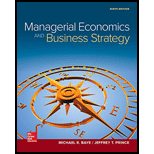
a
To find:Each player’s dominant strategy.
a
Explanation of Solution
Tabular presentation of player 1 and 2 game.
| Player 2 | ||||
| Player 1 | D | E | F | |
| A | -200,150 | 350,100 | -50,600 | |
| B | 200,-300 | 400,400 | 300,100 | |
| C | -150,200 | -250,550 | 750,-350 | |
Dominant strategy is the selection of move in the game which pays the maximum payoff given other player strategy.
According to the table,
| Selection by Player 2 | Reaction of player 1 |
| D | B |
| E | B |
| F | C |
It is noted that, when player 2 selects D, for getting the maximum payoff, player 1 selects B. Similarly, If E is selected by 2nd player, 1 will choose B and so on. Thus, no dominant strategy exists for player 2 as player 2 choices rely on player 1 moves.
Thus, dominant strategy does not occur as players do not have independent moves.
Introduction:
Dominant strategy is the selection of move in the game which pays the maximum payoff given other player strategy.
b)
To ascertain: Each player secure strategy.
b)
Explanation of Solution
According to the game, there are various moves available for player second.
When player 2 choses strategy D, Player 1 has two options, that is, strategy A and C. With selection of A strategy, worst outcome is $-200 and at strategy C, worst outcome is -150.
When player 2 choses strategy E, player 1 has a worst outcome of -50 when strategy E is selected.
When player 2 choses strategy F, Player 1 has two options, that is, strategy A and C. With selection of A strategy, worst outcome is -50 and at strategy C, worst outcome is -350.
To get the secure strategy, maximum payoff available which is $200, $400 or $300 when strategy B is selected. Hence, strategy B is considered as secure strategy for player 1.
Introduction:
A strategy is secure when any deviation from player 2 does not affect the payoff of player 1 having no dominant strategy.
c)
To ascertain: The Nash equilibrium.
c)
Explanation of Solution
Nash equilibrium occurs when both players are maximizing their payoffs given other player’s move.
Therefore, Nash equilibrium occurs when player A choses B strategy while player B choses strategy E which gives payoff equal to each player.
Therefore, the Nash equilibrium in the game is (B,E).
Introduction:
Nash equilibrium is a stable state in which different participants interact each other, in which no participant gain unilaterally, if strategy of other remains unchanged.
Want to see more full solutions like this?
Chapter 10 Solutions
MANAGERIAL ECON.+BUS.STRATEGY (LOOSE)
- 1. We want to examine the comparative statics of the Black Scholes model. Complete the following table using the Excel model from class or another of your choice. Provide the call premium and the put premium for each scenario. Underlier Risk-free Scenario price rate Volatility Time to expiration Strike Call premium Put premium Baseline $50 5% 25% 1 year $55 Higher strike $50 5% 25% 1 year $60 Higher volatility $50 5% 40% 1 year $55 Higher risk free $50 8% 25% 1 year $55 More time $50 5% 25% 2 years $55 2. Look at the baseline scenario. a. What is the probability that the call is exercised in the baseline scenario? b. What is the probability that the put is exercised? c. Explain why the probabilities sum to 1.arrow_forwardSome people say that since inflation can be reduced in the long run without an increase in unemployment, we should reduce inflation to zero. Others believe that a steady rate of inflation at, say, 3 percent, should be our goal. What are the pros and cons of these two arguments? What, in your opinion, are good long-run goals for reducing inflation and unemployment?arrow_forwardExplain in words how investment multiplier and the interest sensitivity of aggregate demand affect the slope of the IS curve. Explain in words how and why the income and interest sensitivities of the demand for real balances affect the slope of the LM curve. According to the IS–LM model, what happens to the interest rate, income, consumption, and investment under the following circumstances?a. The central bank increases the money supply.b. The government increases government purchases.c. The government increases taxes.arrow_forward
- Suppose that a person’s wealth is $50,000 and that her yearlyincome is $60,000. Also suppose that her money demand functionis given by Md = $Y10.35 - i2Derive the demand for bonds. Suppose the interest rate increases by 10 percentage points. What is the effect on her demand for bonds?b. What are the effects of an increase in income on her demand for money and her demand for bonds? Explain in wordsarrow_forwardImagine you are a world leader and you just viewed this presentation as part of the United Nations Sustainable Development Goal Meeting. Summarize your findings https://www.youtube.com/watch?v=v7WUpgPZzpIarrow_forwardPlease draw a standard Commercial Bank Balance Sheet and briefly explain each of the main components.arrow_forward
- Please draw the Federal Reserve System’s Balance Sheet and briefly explain each of the main components.arrow_forward19. In a paragraph, no bullet, points please answer the question and follow the instructions. Give only the solution: Use the Feynman technique throughout. Assume that you’re explaining the answer to someone who doesn’t know the topic at all. How does the Federal Reserve currently get the federal funds rate where they want it to be?arrow_forward18. In a paragraph, no bullet, points please answer the question and follow the instructions. Give only the solution: Use the Feynman technique throughout. Assume that you’re explaining the answer to someone who doesn’t know the topic at all. Carefully compare and contrast fiscal policy and monetary policy.arrow_forward
- 15. In a paragraph, no bullet, points please answer the question and follow the instructions. Give only the solution: Use the Feynman technique throughout. Assume that you’re explaining the answer to someone who doesn’t know the topic at all. What are the common arguments for and against high levels of federal debt?arrow_forward17. In a paragraph, no bullet, points please answer the question and follow the instructions. Give only the solution: Use the Feynman technique throughout. Assume that you’re explaining the answer to someone who doesn’t know the topic at all. Explain the difference between present value and future value. Be sure to use and explain the mathematical formulas for both. How does one interpret these formulas?arrow_forward12. Give the solution: Use the Feynman technique throughout. Assume that you’re explaining the answer to someone who doesn’t know the topic at all. Show and carefully explain the Taylor rule and all of its components, used as a monetary policy guide.arrow_forward
 Managerial Economics: A Problem Solving ApproachEconomicsISBN:9781337106665Author:Luke M. Froeb, Brian T. McCann, Michael R. Ward, Mike ShorPublisher:Cengage Learning
Managerial Economics: A Problem Solving ApproachEconomicsISBN:9781337106665Author:Luke M. Froeb, Brian T. McCann, Michael R. Ward, Mike ShorPublisher:Cengage Learning Exploring EconomicsEconomicsISBN:9781544336329Author:Robert L. SextonPublisher:SAGE Publications, Inc
Exploring EconomicsEconomicsISBN:9781544336329Author:Robert L. SextonPublisher:SAGE Publications, Inc Managerial Economics: Applications, Strategies an...EconomicsISBN:9781305506381Author:James R. McGuigan, R. Charles Moyer, Frederick H.deB. HarrisPublisher:Cengage Learning
Managerial Economics: Applications, Strategies an...EconomicsISBN:9781305506381Author:James R. McGuigan, R. Charles Moyer, Frederick H.deB. HarrisPublisher:Cengage Learning





